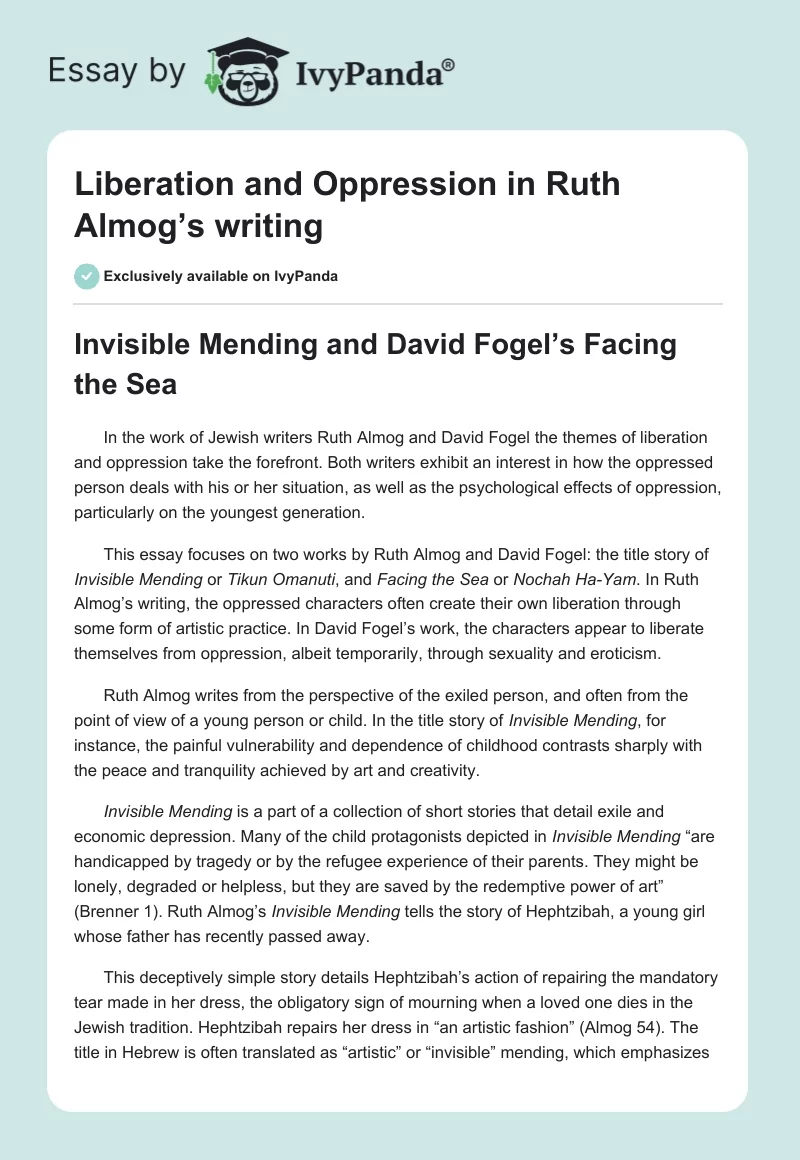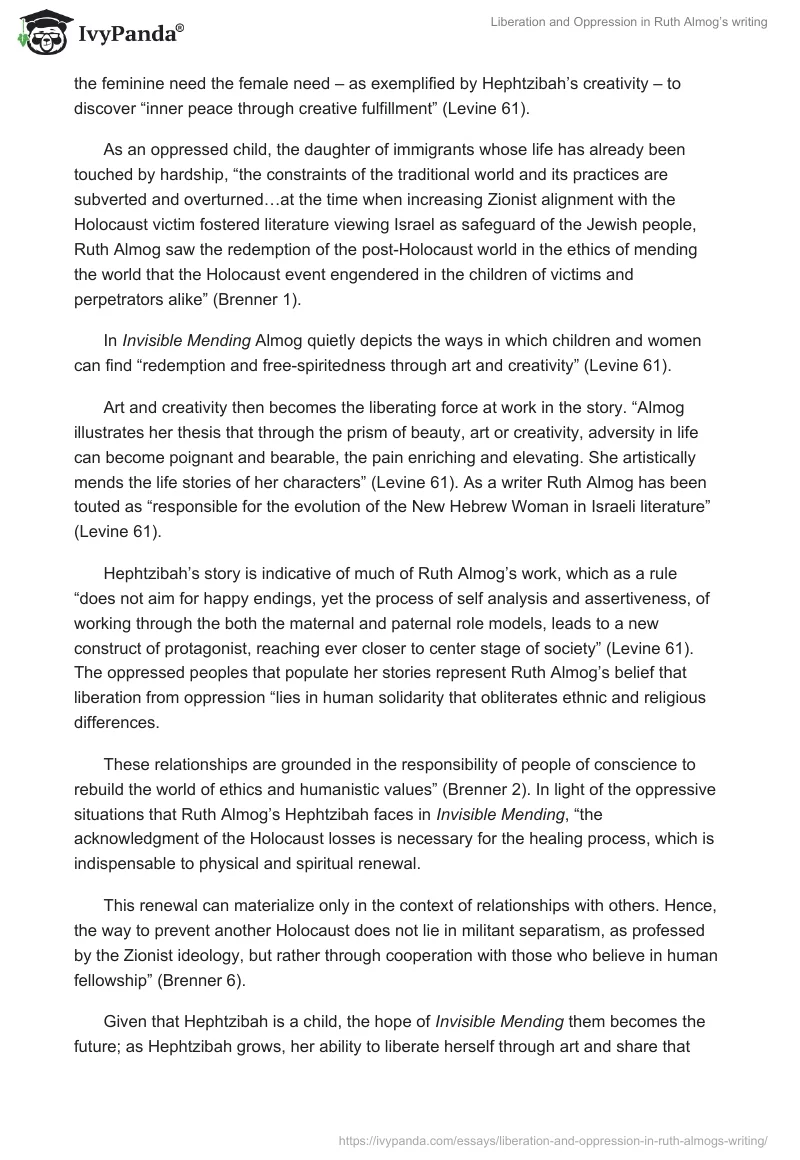Invisible Mending and David Fogel’s Facing the Sea
In the work of Jewish writers Ruth Almog and David Fogel the themes of liberation and oppression take the forefront. Both writers exhibit an interest in how the oppressed person deals with his or her situation, as well as the psychological effects of oppression, particularly on the youngest generation.
This essay focuses on two works by Ruth Almog and David Fogel: the title story of Invisible Mending or Tikun Omanuti, and Facing the Sea or Nochah Ha-Yam. In Ruth Almog’s writing, the oppressed characters often create their own liberation through some form of artistic practice. In David Fogel’s work, the characters appear to liberate themselves from oppression, albeit temporarily, through sexuality and eroticism.
Ruth Almog writes from the perspective of the exiled person, and often from the point of view of a young person or child. In the title story of Invisible Mending, for instance, the painful vulnerability and dependence of childhood contrasts sharply with the peace and tranquility achieved by art and creativity.
Invisible Mending is a part of a collection of short stories that detail exile and economic depression. Many of the child protagonists depicted in Invisible Mending “are handicapped by tragedy or by the refugee experience of their parents. They might be lonely, degraded or helpless, but they are saved by the redemptive power of art” (Brenner 1). Ruth Almog’s Invisible Mending tells the story of Hephtzibah, a young girl whose father has recently passed away.
This deceptively simple story details Hephtzibah’s action of repairing the mandatory tear made in her dress, the obligatory sign of mourning when a loved one dies in the Jewish tradition. Hephtzibah repairs her dress in “an artistic fashion” (Almog 54). The title in Hebrew is often translated as “artistic” or “invisible” mending, which emphasizes the feminine need the female need – as exemplified by Hephtzibah’s creativity – to discover “inner peace through creative fulfillment” (Levine 61).
As an oppressed child, the daughter of immigrants whose life has already been touched by hardship, “the constraints of the traditional world and its practices are subverted and overturned…at the time when increasing Zionist alignment with the Holocaust victim fostered literature viewing Israel as safeguard of the Jewish people, Ruth Almog saw the redemption of the post-Holocaust world in the ethics of mending the world that the Holocaust event engendered in the children of victims and perpetrators alike” (Brenner 1).
In Invisible Mending Almog quietly depicts the ways in which children and women can find “redemption and free-spiritedness through art and creativity” (Levine 61).
Art and creativity then becomes the liberating force at work in the story. “Almog illustrates her thesis that through the prism of beauty, art or creativity, adversity in life can become poignant and bearable, the pain enriching and elevating. She artistically mends the life stories of her characters” (Levine 61). As a writer Ruth Almog has been touted as “responsible for the evolution of the New Hebrew Woman in Israeli literature” (Levine 61).
Hephtzibah’s story is indicative of much of Ruth Almog’s work, which as a rule “does not aim for happy endings, yet the process of self analysis and assertiveness, of working through the both the maternal and paternal role models, leads to a new construct of protagonist, reaching ever closer to center stage of society” (Levine 61). The oppressed peoples that populate her stories represent Ruth Almog’s belief that liberation from oppression “lies in human solidarity that obliterates ethnic and religious differences.
These relationships are grounded in the responsibility of people of conscience to rebuild the world of ethics and humanistic values” (Brenner 2). In light of the oppressive situations that Ruth Almog’s Hephtzibah faces in Invisible Mending, “the acknowledgment of the Holocaust losses is necessary for the healing process, which is indispensable to physical and spiritual renewal.
This renewal can materialize only in the context of relationships with others. Hence, the way to prevent another Holocaust does not lie in militant separatism, as professed by the Zionist ideology, but rather through cooperation with those who believe in human fellowship” (Brenner 6).
Given that Hephtzibah is a child, the hope of Invisible Mending them becomes the future; as Hephtzibah grows, her ability to liberate herself through art and share that liberation with others will lead to the redemption of her family and her neighbors. Invisible Mending thus becomes a hopeful vision of a humanist future.
David Fogel was born at a dangerous time of history for Jewish writers and experienced firsthand the brutality of the Nazi regime. Born in Russia, David Fogel was mostly known as a poet and spent much of his career traveling Europe and spent time in Austria, Tel Aviv and Berlin before settling in Paris.
He was arrested twice for being Jewish: once in Vienna in 1914, and again by the Nazis in Paris when the Second World War erupted. Upon his second arrest David Fogel was deported, and after that no record of him ever resurfaced. Historians assume David Fogel was murdered in one of the concentration camps.
In the novella Facing the Sea, which David Fogel wrote in Paris and published in 1932, this is the story of a couple spending a summer vacation together on the French Riviera. The story divulges next to nothing of the couple’s past relationship over the course of the telling. Their hotel is small and homey and run by a genial landlady whose hotel attracts similar urban, European upper middle-class tourists as well as some of the locals from the nearby village.
At the end of the novella a woman from France visits the husband, who is in laid up ill at the hotel while his wife takes a day trip to Nice. The liberation David Fogel writes of is decidedly apolitical on the surface – it appears to be simply about the husband’s erotic fantasy in the absence of his wife – however as critic Michael Gluzman points out, “in his political passivity and silence David Fogel stands in clear opposition to the politically committed literary establishment of his period” (Gluzman 22).
David Fogel wrote of oppression as a state of mind that affected all relationships – both personal and professional – and he wrote from his own experience as an individual under threat. Despite his frequent encounters with hostile political authorities, David Fogel was a man who tried to have a normal life (Abramson 934).
He married in 1926 and made his living as a teacher up until the time of his disappearance (Abramson 934). His work speaks to the impact that oppression has on these personal attempts at liberty – how it can sour them – and specifically in the case of Facing the Sea, David Fogel’s works reveals the private fantasy world of eroticism that the oppressed retreat to when they feel they have no other form of personal space.
Works Cited
Abramson, Glenda. “David Fogel.” Encyclopedia of Modern Jewish Culture. London: Routledge, 2005. Print.
Almog, Ruth. Invisible Mending. Jerusalem: Keter, 1993. Print.
Brenner, Rachel Feldhay. “Ideologically Incorrect: Responses to the Holocaust by Three Israeli Women Writers.” CLCWeb: Comparative Literature and Culture 11.1 (2009): 1-6. Web.
Fogel, David. “Facing the Sea.” Eight Great Hebrew Short Novels. New York: New American Library, 1983. Print.
Gluzman, Michael. “Unmasking the Politics of Simplicity in Modernist Hebrew Poetry: Rereading David Fogel.” Prooftexts. 13.1 (1993): 21-43. Web.
Levine, Tamara. “Ruth Almog.” Jewish Writers of the Twentieth Century. London: Taylor & Francis, 2003. Print.


